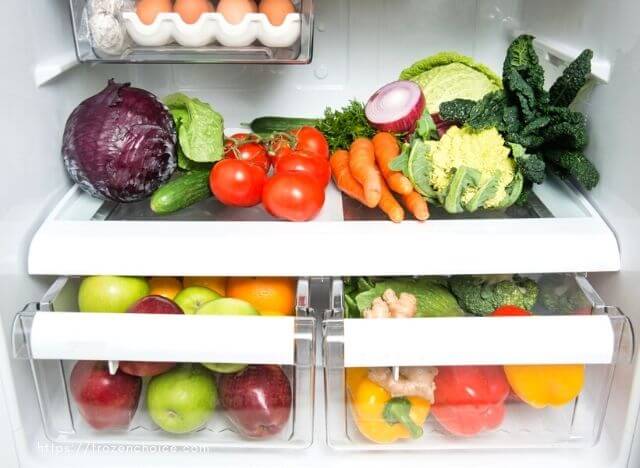Properly storing food in the refrigerator will help to preserve the full flavor and nutrients of food for later use. In this article, you will find information on why it’s important to preserve food, how to properly store different foods in fridge, and what should be done for refrigeration and food safety.
Why food need to be refrigerated?
The purpose of food preservation in fridge is to prevent the food spoilage.
The main causes of food spoilage and rancidity include:
- Due to the action of enzymes available in food
- Because of the oxidation to make food breaks down
- Due to the invading microorganisms and bacteria that spoil food
The above causes are influenced by temperature. The higher the temperature, the faster the decomposition; the lower the temperature, the slower the decomposition. Refrigeration slows down the breakdown of food.
Why do you need to store food in fridge properly?
The wrong way of storing food in the refrigerator will lead to potential risks. Any kind of food, raw or cooked, should be kept in the refrigerator for later use. However, we need to store them properly to protect our health.
What is the impact of improper food storage?
When storing food in the refrigerator, the microorganisms just stop working. If food is not stored properly, these microorganisms will spread to other foods, which can lead to a high risk of food poisoning when we use them.
When eating food that is not properly stored in fridge, we may experience discomfort symptoms like fever, nausea, and abdominal pain. At that time, we may be infected with bacteria that are harmful to our health.
The two different types of bacteria include pathogenic bacteria which cause foodborne illness, and spoilage bacteria which make foods to deteriorate and develop unpleasant smells, tastes, and textures.
The bacteria in the refrigerator can be named as Salmonella, Listeria, Escherichia coli, Staphylococcus aureus… Many people think that bacteria will be killed in a low temperature environment. But in fact, many bacteria can survive in an environment between 0 and -45 degrees Celsius.
How to properly store food in fridge
To keep food fresh in fridge, you need to sort them out before storing. They can be grouped as:
- Meat, fish, seafood
- Fresh fruits
- Vegetables
- Cooked food
The cooling compartment is the place where the most food is stored, so odors in the refrigerator are most likely to form here. You need to sort foods before putting them in the refrigerator, especially fruits and vegetables.
Further reading: Which Refrigerator is the Best for a Family with 4-5 Members?
How to store meat, fish and seafood
Following these steps:
First, wash them with clean water and drain meat, fish, shrimp, seafood (if necessary).
Next, divide into small portions corresponding to 1 serving, cover with Ziploc bags or food containers with lids. It will be convenient for use later. Avoid defrosting large quantities of food while you are using only a few. Add some seasoning if needed.
You can make use of a vacuum sealer to keep your meat fresher and safer in fridge.
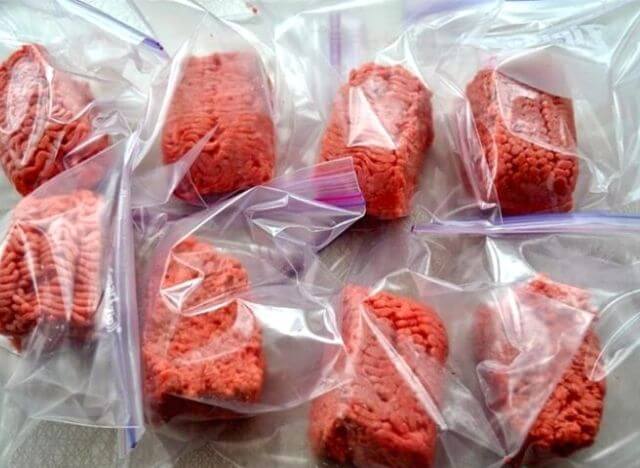
Finally, put it in the refrigerator (from 2 to 4 degrees Celsius) with a shelf life of 3-5 days. If it stays in freezer compartment (about -18 degrees Celsius), its shelf life can be up to 12 months, but the sooner you use it, the better.
You may also like: Is It Safe to Eat Freezer Burned Meat or Fish?
How to store fresh fruits
3 steps to store fresh fruits in the refrigerator
- Choose the fresh and just-ripe fruits, so you can preserve them for a long time
- Clean the stalk and remove the damaged part (if any)
- Wrap fruit in mesh bags, canvas bags, or perforated plastic bags which can prevent fruit from anaerobic respiration.
Notes:
- The best temperature to store fruit is between 3 to 5 degrees C.
- Fruits should not be stored with vegetables as fruits will emit ethylene gas, causing vegetables to be damaged and waterlogged.
- The fruit that is bought first should be arranged in a conspicuous position to use first.
- Leftover fruit, you should peel it, cut it into small pieces and put it in a food container. Store in the refrigerator for 1-2 days only.
How to store vegetables
With vegetables, you should not wash them if you do not use them right away.
You need to remove the waterlogged, wilted parts and remember do not let the vegetables get wet. Then, you divide the vegetables in a small amount, then put them in a zip bag or plastic bag (with air holes) and put in the vegetable drawer. As this drawer is specifically designed, it maintains optimal temperature and humidity, making vegetables fresher.
3 steps to preserve vegetables in the refrigerator.
- Remove damaged or waterlogged parts of vegetables.
- Put vegetables in perforated paper or plastic bags.
- Put in the vegetable storage compartment to store at a temperature of 3 to 5 degrees C.
Notes:
- Do not wash vegetables before letting them go into the refrigerator.
- Do not cut vegetables.
- Vegetables and fruits should be kept separate from each other.

Vegetables that do not need to be refrigerated:
- Potatoes: just need a dry, airy place.
- Sweet potatoes: store in a slightly dark place, away from heat and light.
- Pumpkin (including zucchini and squash): store in a cool, dry place.
- Unripe tomatoes: place in basket at room temperature.
Further reading: How to Store Vegetables in the Fridge for Long Time
How to store cooked food in fridge
Cooked food is one of the biggest sources to emit unpleasant odors in refrigerator. The odor can be cross contaminated with other foods.
With cooked food, you need to let it completely cool (in 1 or 2 hours) before putting it in a food container, cover it and place it at a temperature of 2-4 degrees Celsius. If you put hot food in the refrigerator, it will easily increase the temperature and affect other foods as well as make the compressor work more, affecting the lifespan of the refrigerator.
To store cooked foods, you should put them in containers with tight-fitting lids before putting them in the refrigerator.
The cooked food can stay safe up to 2-3 days in the ideal temperature of 2-4 degrees Celsius.
Foods that you should not put into the fridge
You often store fruits and vegetables in the refrigerator, but there are food that should not store in the fridge. When storing these foods in the refrigerator, the taste will be reduced, not good to use, even nutrients will be lost.
Bread: Bread will easily dry and become hard at low temperatures, especially quickly gets mold if the refrigerator environment is not clean. The best way to store bread is in a bag with air holes at room temperature.
Onions: Onions tend to soften or mold if left in the fridge for too long. If onions have been chopped, they will dry out quickly. The best way to store onions is to them in a paper bag and place in a cool, dark place. Also, avoid storing onions with potatoes, as potatoes release steam and gas that can damage onions faster.
Potato: When keeping at cold temperatures, potatoes turn starches into sugars, so the taste will not be as delicious as before. The best way to store potatoes is at room temperature.
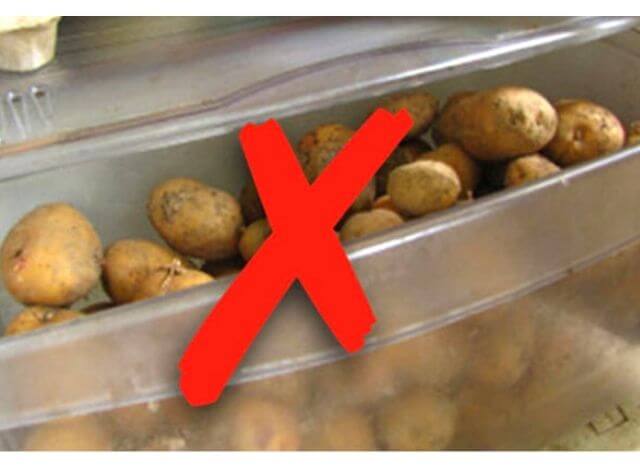
Bananas: Keeping bananas in the fridge will lose their flavor and nutrition. Like bananas, you should not store avocados, apples, and apricots for too long in the refrigerator.
Coffee: When storing coffee in the refrigerator, it will lose its flavor and cause bad odors in the refrigerator. Instead, store your coffee in a cool, dark place to preserve its flavor.
Honey: Honey is a good natural preservative, it’s safe to place in room temperature as it will retain quality and flavor for many years.
Garlic: Like other spices such as ginger, chili, onions, … garlic is extremely sensitive to low temperature. It’s better to keep them in a cool and dry place to prolong their shelf life.
How to arrange foods in the fridge correctly
First, you need to set the refrigerator at 40 degrees F. Then, food should be arranged in the fridge as below:
Freezer compartment
This is where the temperature is very low, at about 0 °F. You should store fresh foods that you want to keep for a long time such as meats, fish, seafood, etc. You can also make ice cubes, ice cream or yogurt.
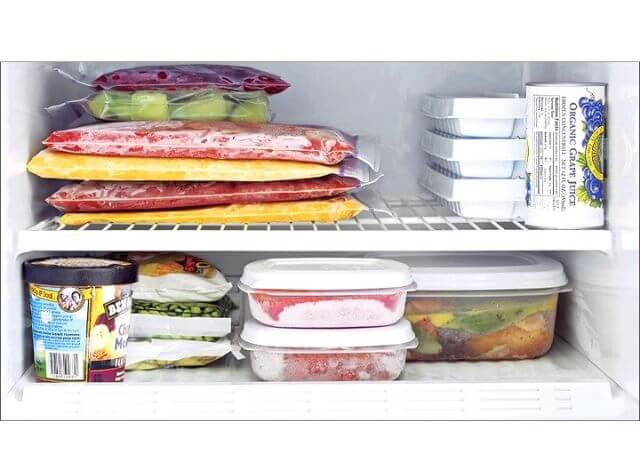
Raw foods should be wrapped well to avoid cross-contamination of other foods.
To ensure that the cold air is evenly distributed throughout the freezer compartment, do not arrange foods to cover the evaporator.
Further reading: How Often Should You Defrost a Fridge?
Refrigerator door
Because the temperature fluctuates a lot, you can only keep dry foods or spices and sauces here. In the bottom shelf, put heavy items like bottles.
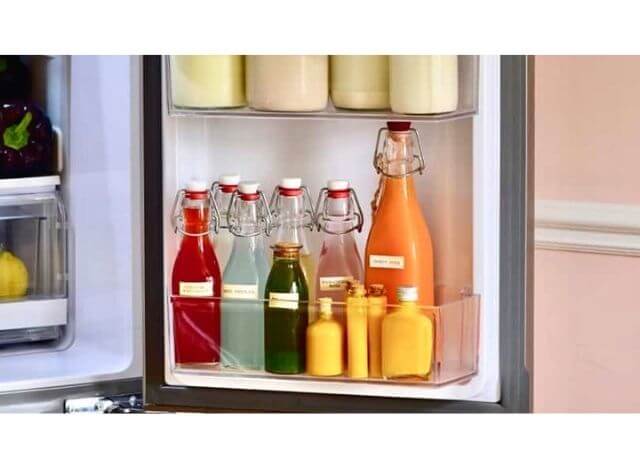
Top shelf
Put foods such as leftovers, drinks or ready-to-eat foods here, because this place has the right temperature to keep them longer and stay fresh.
Lower shelf
It’s for eggs, milk, meats or seafood you want to use quickly or defrost. However, you should wrap meat, seafood, etc. and put them in a safe container to avoid leaking water into other foods.
Drawer
The cabinet is designed to maintain the right humidity for vegetables, tubers and fruits. Drawer is the most suitable place to keep fresh vegetables and fruits in the refrigerator.
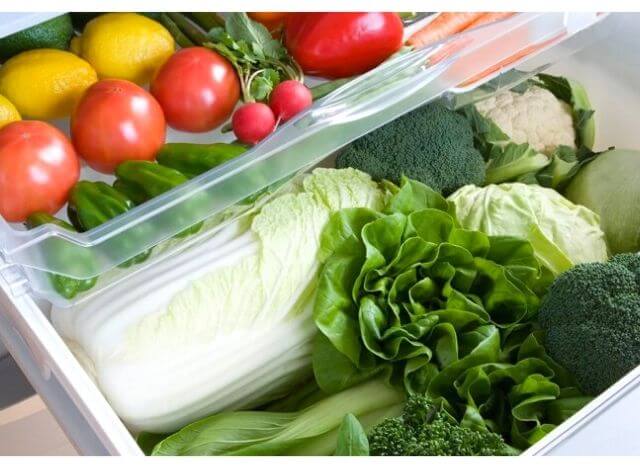
You may also like: 10 Best Mini Fridges with Freezer
Why is food container important?
Food containers are very useful items to support food preservation in the refrigerator.
Main uses of the food container:
- Prevents food from losing its smell
- Helps to avoid cross-contamination of foods
- Help keep cold air inside the refrigerator clean
Foods that should use food containers:
- Fresh foods
- Cooked food
- Leftovers
- Green vegetables
- Spices and seasonings
Further reading: What are the Best Food Storage Containers for Fridge?
Should you store strong-smell food in the fridge?
Foods that have strong odors
They can be listed as onions, garlic, potatoes, galangal,… you should not put them in the refrigerator. These foods are easy to germinate and cause unpleasant odors in the refrigerator, affecting other foods…
Coffee beans and powder
Coffee stored in the refrigerator will lose all its delicious flavor. In addition, coffee has strong deodorizing properties, which can make other foods lose their smell.
However, if you want to deodorize the refrigerator, you can use coffee bait to put it in the refrigerator for a few hours.
Unripe bananas and avocados
If you put green bananas in the refrigerator, bananas will be very difficult to ripen and even become mushy, causing spoilage. So are the avocados.
Conversely, after bananas and avocados are ripe, you can put them in the refrigerator to preserve.
Refrigeration & food safety: according to USDA (U.S Department of Agriculture)
Following are the guidelines for refrigeration & food safety from USDA.
Adjust the right temperature
You should set your refrigerator at a temperature of 40 °F or below. The freezer needs to be at 0 °F to keep food safe.
In addition, make sure the fridge or freezer doors are always closed tightly. You should not open refrigerator/freezer doors when it’s not necessary.
Handling foods for storing
Hot foods should be rapidly cooled in ice water before refrigerated. Cover foods to retain moisture and prevent them from catching odors from other foods.
With large food, divide it into small portions and place them in a safe container before going into the refrigerator.
Food arrangement
To be safe for storing any food, the internal temperature of a refrigerator should be 40 °F or below.
Take advantage of features such as adjustable shelves, door bins, crisper, … to store foods more convenient and to provide an optimal storage environment for all kinds of foods.
Foods stored on the fridge door
Never store perishable foods like eggs in the fridge door as the temperature here is not stable when the door is opened and closed very often. You should keep the door closed as much as possible.
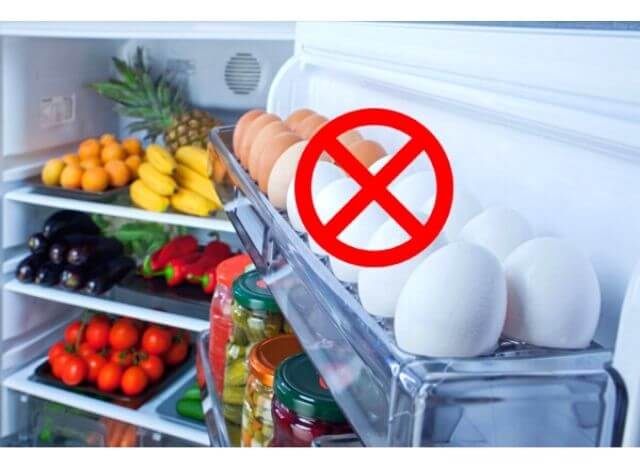
Refrigerator cleaning
Cleaning should be done regularly to limit the growth of mold and bacteria. We need to clean 1-2 times a month or whenever the compartments get dirty.
Removing odors
To get rid of refrigerator odors, you can use different kinds of cleaning solutions like vinegar, baking soda and water or fresh coffee grounds.
If using fridge cleaner available at stores, remember to follow the manufacturers’ instructions.
Never forget this
Refrigerator is an indispensable item for every home. Therefore, you should equip yourself with the knowledge to properly store food in the fridge. This prevents food from being spoiled, rancid, spreading harmful bacteria and avoid the risk of food poisoning.
To properly store food in fridge, you should never forget the following key points:
- Sort food before putting it in the fridge
- Pack food safely
- Don’t put too many things in the fridge
- Set the right temperature to preserve each type of food
- Clean the refrigerator regularly
- Organize food properly
- Do not leave food for too long
- Be careful when storing smelly foods
- Use a refrigerator with appropriate preservation functions
Reference:
1. Food safety handling, fsis.usda.gov, Retrieved on March. 4, 2022
2. Keeping food safe in your fridge, safefood.net, Retrieved on March. 3, 2022

